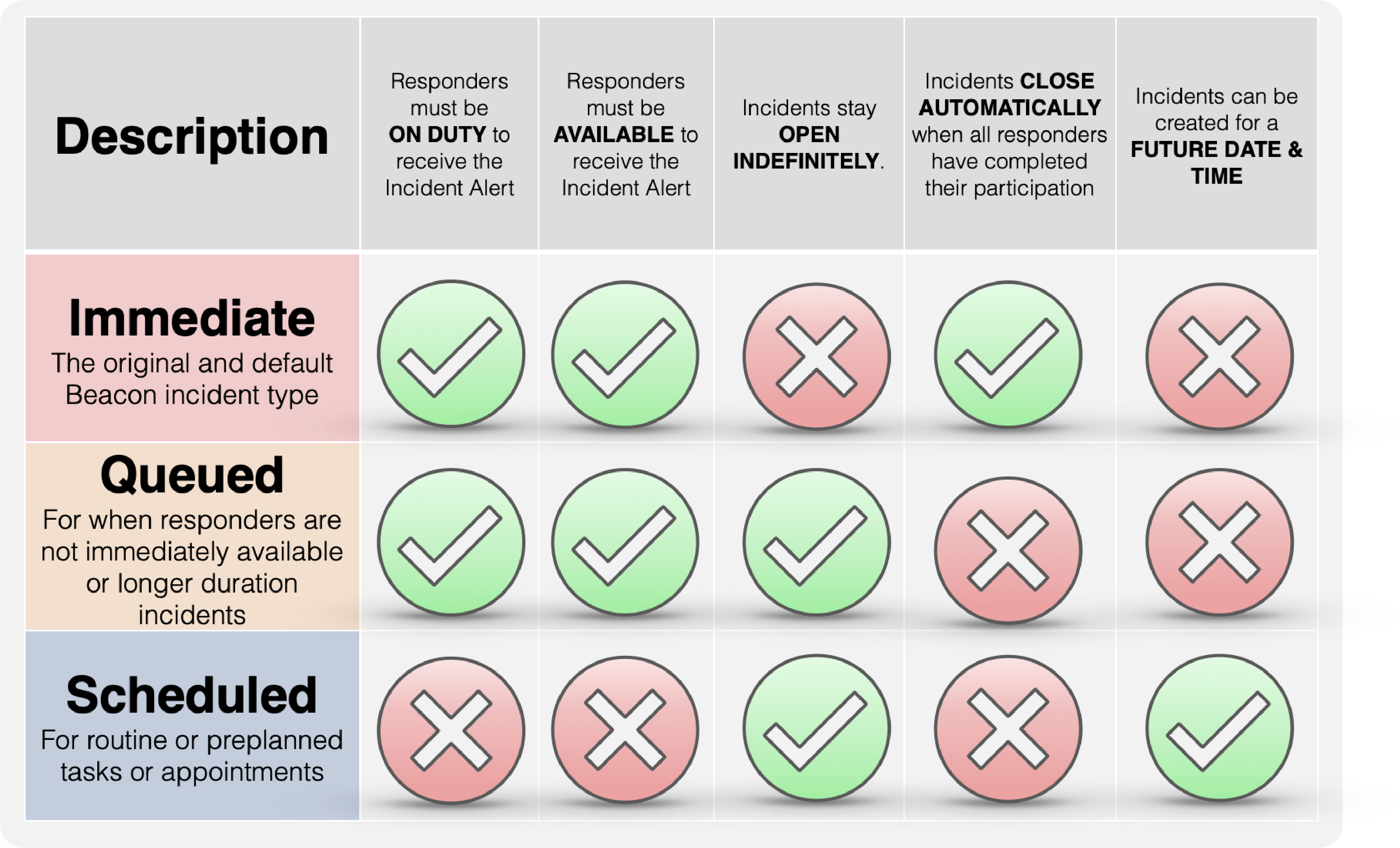Beacon now provides for the creation of three different incident priority types to better meet the needs of different response agencies:
Immediate – Requires immediate attention
Queued – As soon as Responders are available
Scheduled – Future dated tasks

Visit the dispatcher guide section here to learn how to activate the different incident priority on your agency account.

If your agency has enabled the use of multiple Incident Priority you should be able to use this feature if you have the Mobile Dispatcher Permission.
1. Priority Selector

2. Queued Hold

- Incident Priority selectors will appear between the incident location and the description fields when creating a new incident as shown in the first image above.
- Also notice on the second image that we have included a Hold checkbox when selecting a Queued Incident. Checking the box will allow the creation of the queued incident without generating an incident alert to available responders. After the incident is created, dispatchers can manually assign responders to this incident and each responder assigned will receive an alert.
** Pay attention that the Hold checkbox will disappear if you chose to Pre-Assign responders while creating the incident, meaning it will generate an alert.
Once created, Queued on Hold Incidents will display an icon indicator for easy identification on the Mobile App
The On-Hold icon indicator will be visible on the:
Incident Info Card

Mobile App Sidebar

“WHICH INCIDENT PRIORITY SHOULD WE USE?”
These questions will help you decide which one(s) to enable.
“Do you need Responders to assist someone as soon as possible?”
- If “Yes”, enable Immediate Incidents
- Immediate Incidents require Responders who are On Duty and Available (i.e., not already assigned to another active incident)
- Immediate Incidents will close once all assigned Responders have completed their involvement
SAMPLE USE CASE 1:
Someone is suffering a life- or limb-threatening situation and needs emergency assistance right now.
A dispatcher would create an Immediate Incident to make sure that the right Responders were assigned to assist right away.
Do you expect to have more Incidents than you have Responders?”
or
“Can the Incidents wait until Responders become available to assist?
- If “Yes”, enable Queued Incidents
- Queued Incidents are useful for when Responders are not immediately available or for longer duration incidents
- Queued Incidents can be created when no other Responders are available and will stay open until the Dispatcher closes them
SAMPLE USE CASE 2: An agency has only three Responders working this shift. They are all currently assisting someone though more requests for assistance are coming in.
SAMPLE USE CASE 3: A search and rescue team has to search 20 houses for survivors in a single neighborhood over the next three hours.
In both use cases, a Dispatcher would create multiple Queued Incidents to ensure that Responders would be able to get to each and every Incident as they are able.
“Do you know well in advance of when your Responders will be needed?”
- If “Yes”, enable Scheduled Incidents
- Scheduled Incidents can be created for a future date and time
- Scheduled Incidents are created on the date and time selected by the Dispatcher
- Scheduled Incidents don’t require Responders to be On Duty and/or Available to create them
- Responders will receive the Scheduled Incident alert at the selected date and time
SAMPLE USE CASE 4: An ambulance service provides inter-facility transfers for dialysis patients and has regularly scheduled transfers to and from the dialysis clinic.
A Dispatcher would create Scheduled Incidents for the appropriate date/time and alert selected Responders to the Incident at the selected date/time.
TEST YOUR KNOWLEDGE OF INCIDENT PRIORITY TYPES
Included here are multiple scenarios that Dispatchers may encounter. Click on the arrow button to reveal which Incident Priority type is recommended.
USE CASE 5 — Someone calls to report a motor vehicle collision with multiple victims. The caller says some victims are still trapped in the vehicle and also mentions that they can smell gasoline.
USE CASE 6 — Someone calls to report an opioid overdose.
USE CASE 7 — You are an advocacy group that sends crisis counselors to provide support services to victims of non-life-threatening injuries. Police has called your call center to request one of your counselors, but you don’t have anyone available at the moment because they are all on other calls.
USE CASE 8 — There is an upcoming drill that requires the attendance of various but not all responders from the shift.
 Dispatcher Resources
Dispatcher Resources Responder Resources
Responder Resources FAQ
FAQ Status Updates
Status Updates